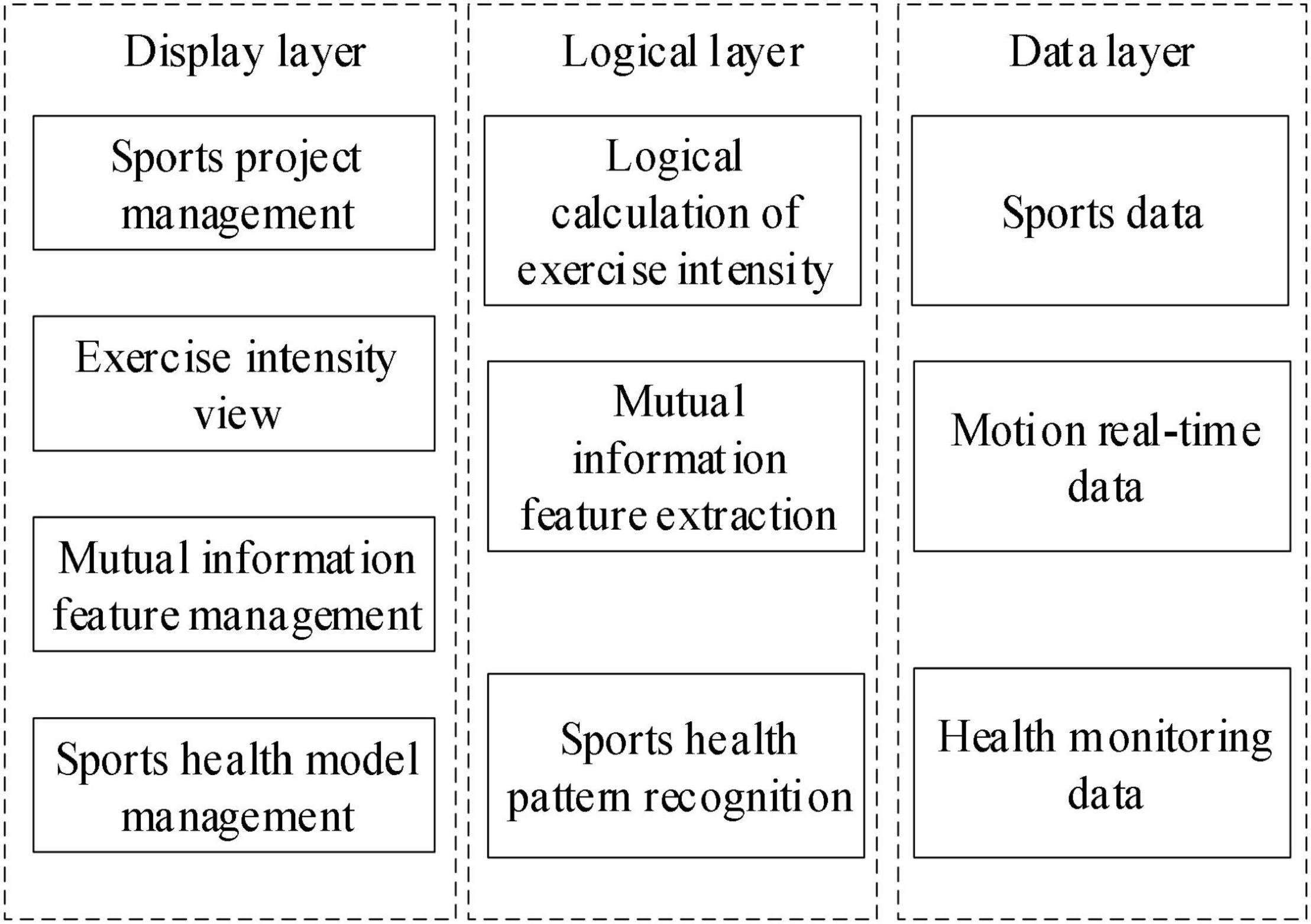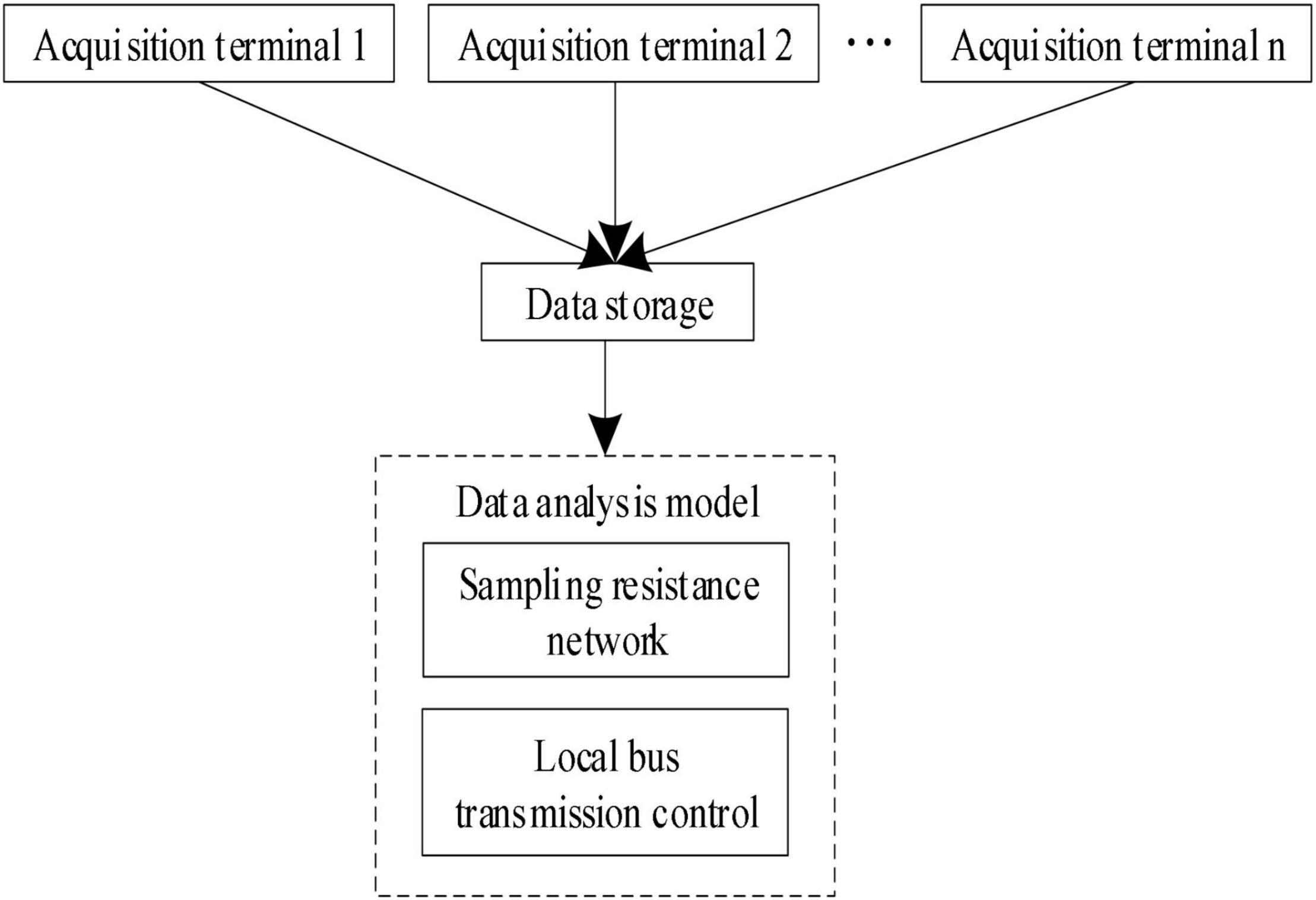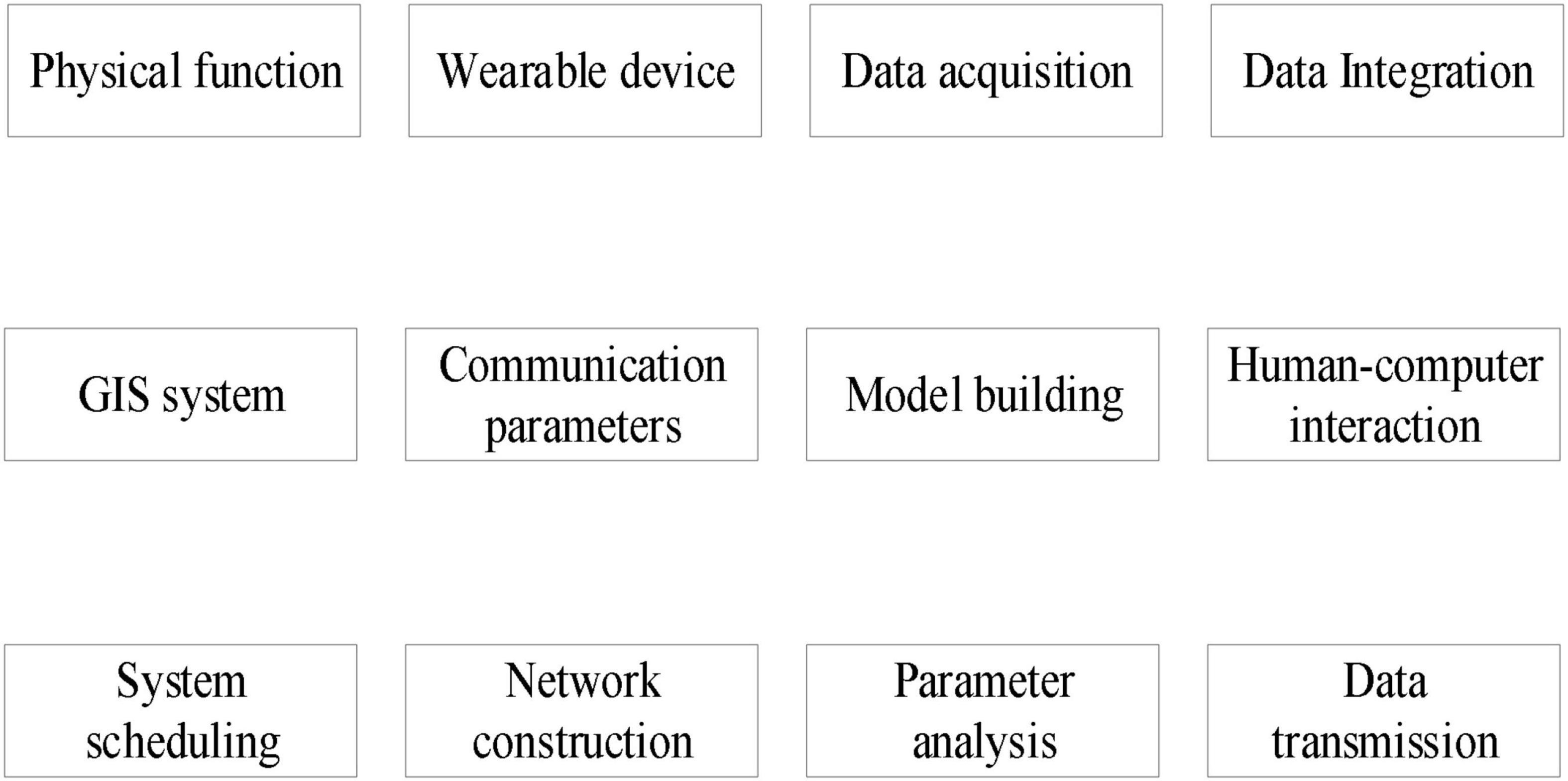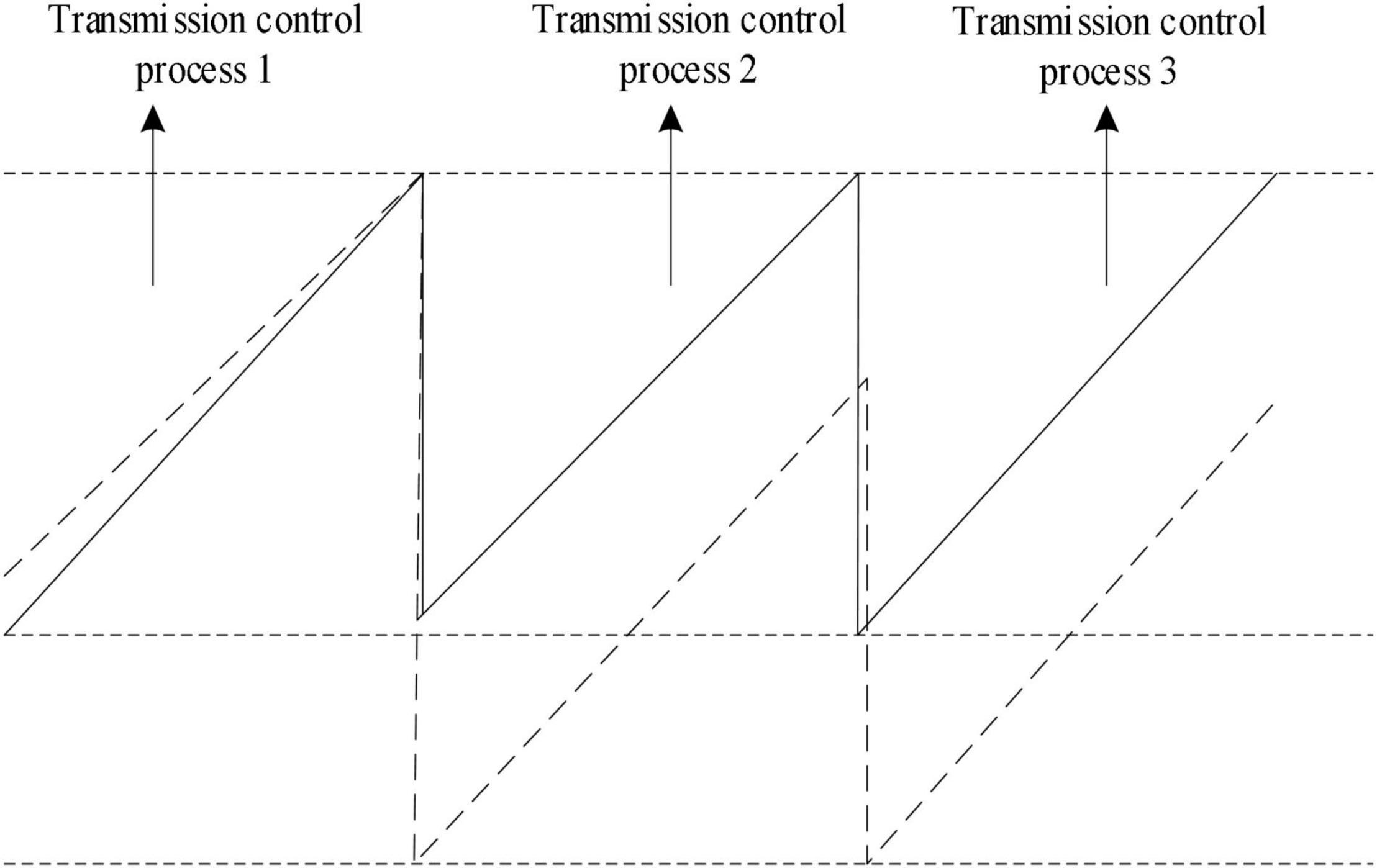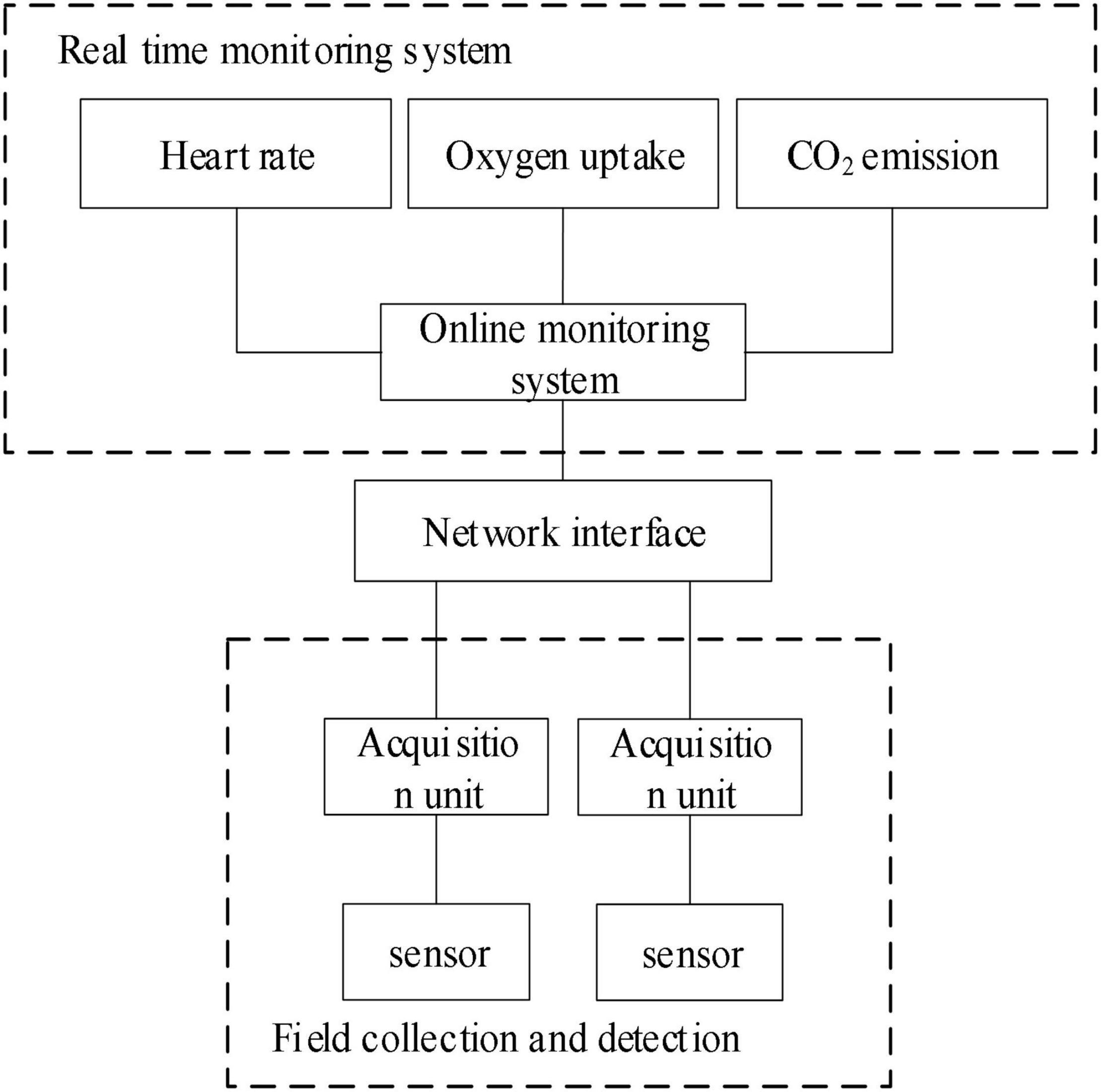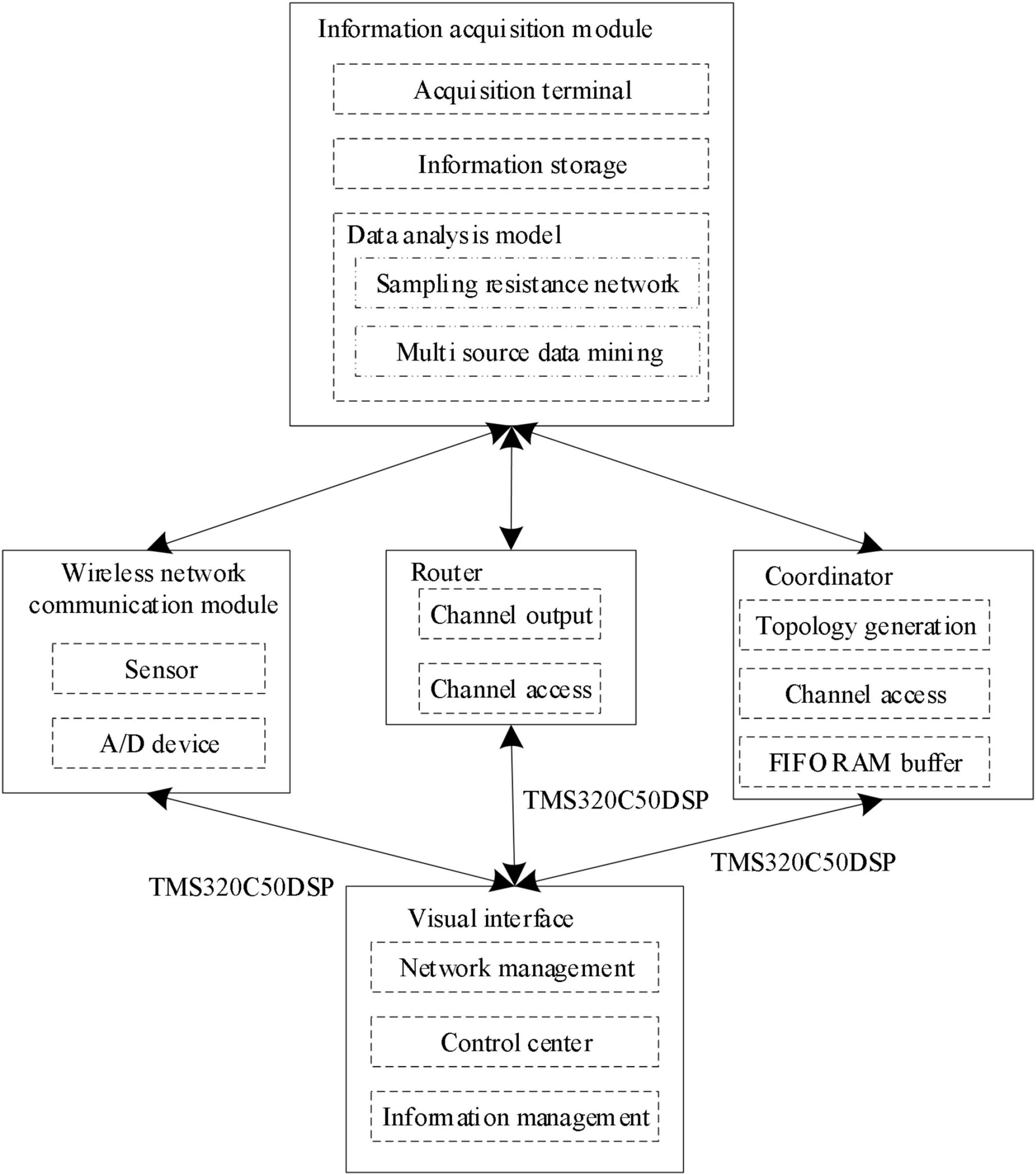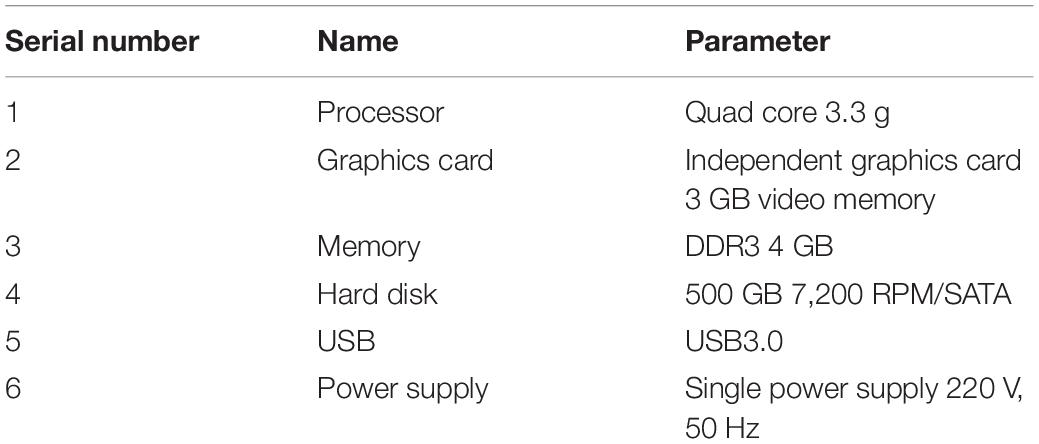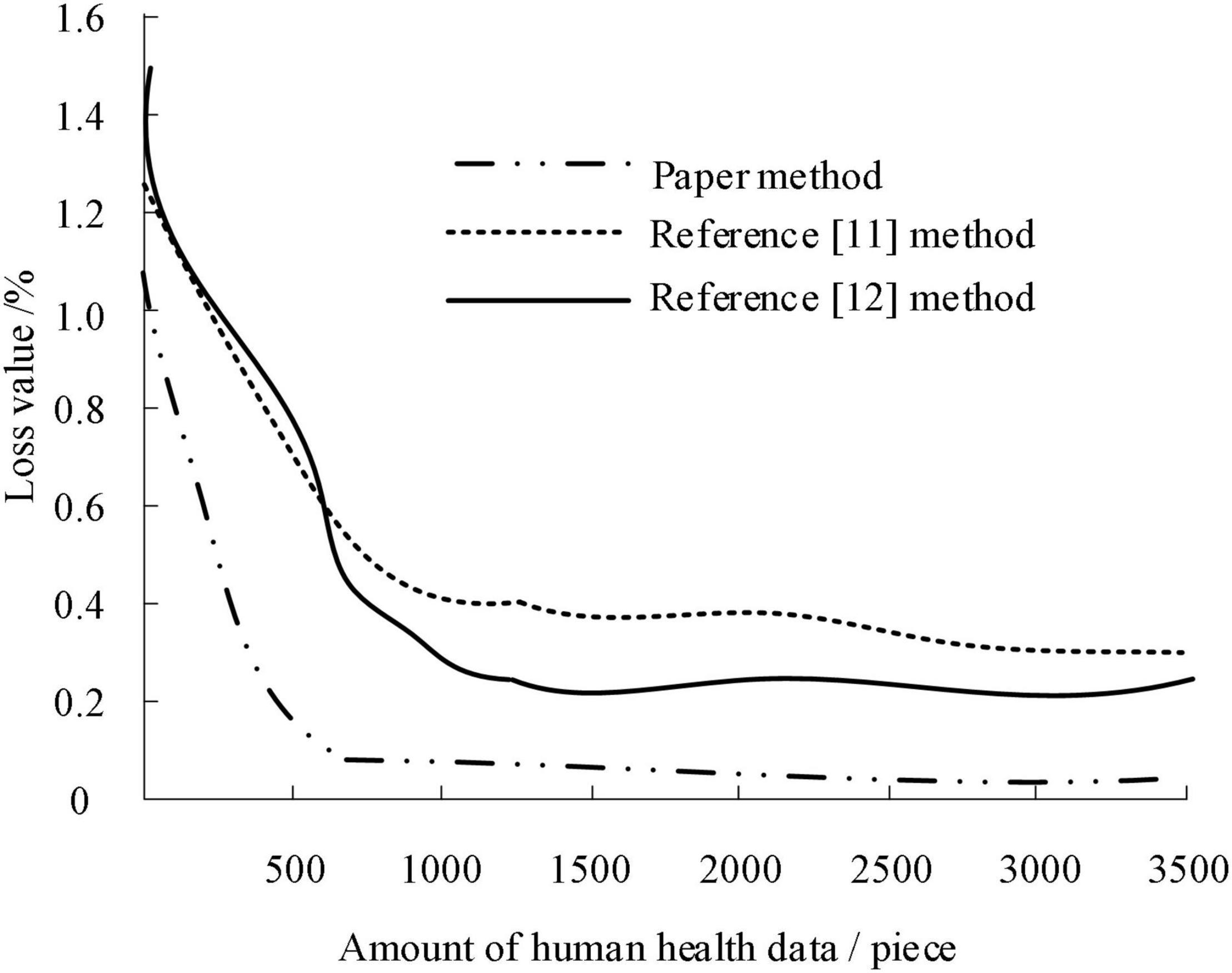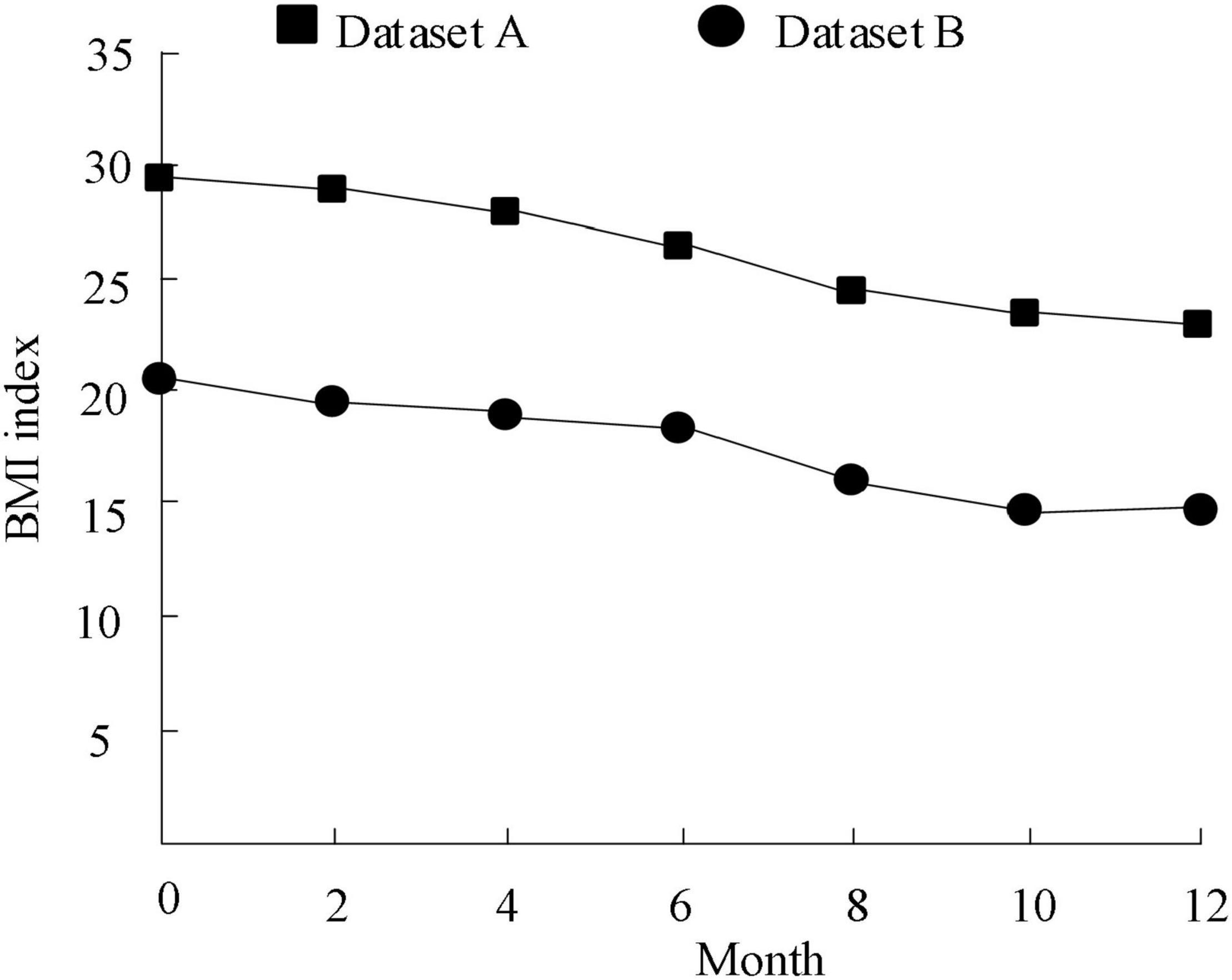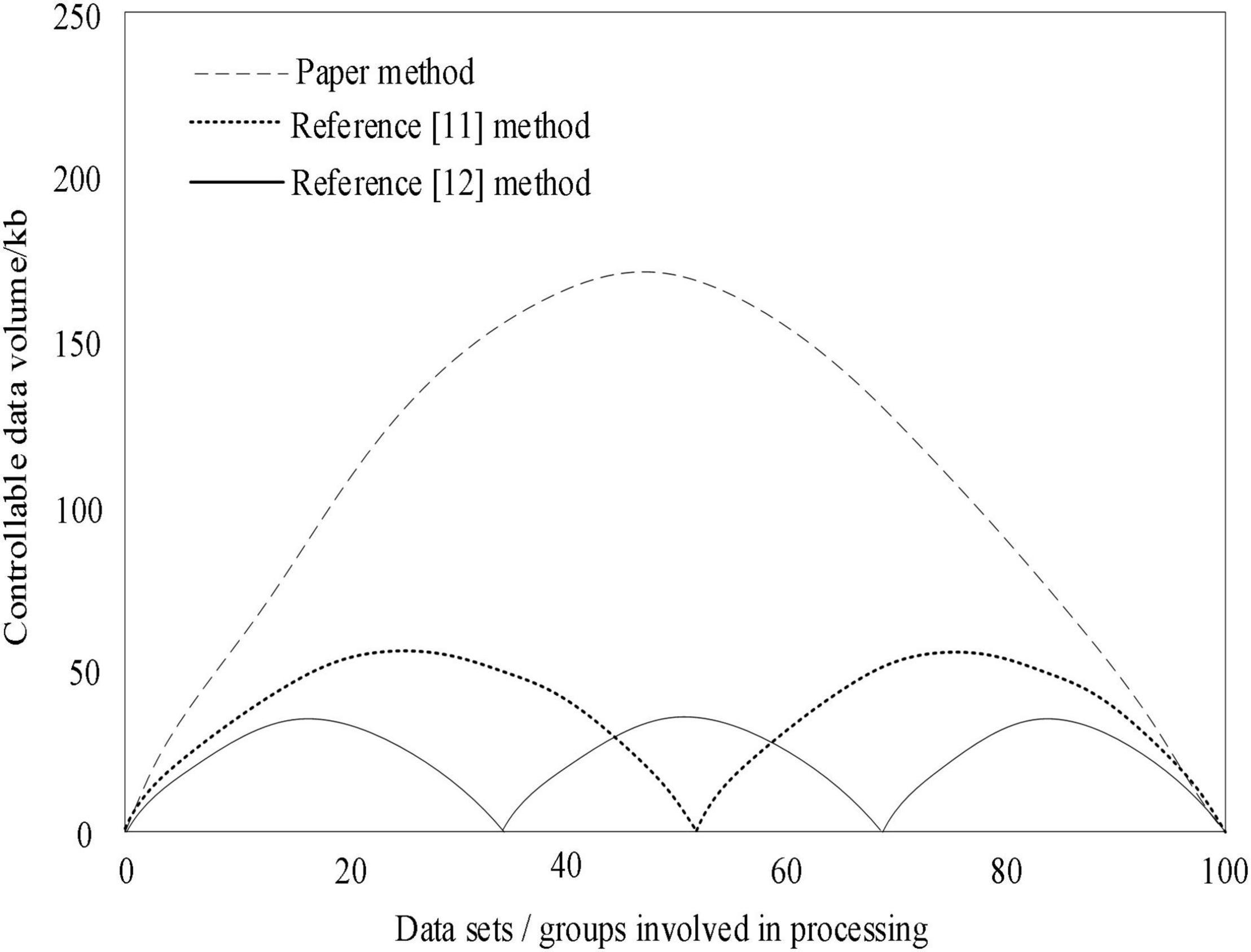- 1School of Physical Education, Harbin University, Harbin, China
- 2Harbin Institute of Physical Education, Harbin, China
This paper presents the purpose of sport recognition of mental health for users and analyzes and studies the recognition of mental health by sports based on deep learning. The recognition model of sport mental health state composed of data layer, logic layer and display layer is built. After fusing human health data with deep learning algorithm, the feature of human health mutual information is extracted, the feature into the recognition model of mental health state is inputted, and the recognition results of sport mental health mode after forward and reverse operation are outputted. The recognition data of sports on mental health status are obtained, which correspond to the link flowing through during multi-level transmission, calibrate the multi-level transmission point, and fuse and process the recognition information of sports on mental health status. The experimental results show that the loss value of the research method when analyzing the effect of sports on mental health enhancement is the smallest, the output result is reliable, can effectively improve the body mass index (BMI) of the human body, has the most controllable amount of data, and has good performance.
Introduction
Human health includes not only the physiological level, but also the psychological level. Physiological and mental health interact and complement each other (Pardos et al., 2021). With the continuous development of social civilization, people’s understanding and research on the content and importance of mental health are also deepening (Bessonov and Nametkin, 2020; Kumar et al., 2021). Mental health has its external performance and internal characteristics. Good social adaptation is its external performance, and good psychological quality is its internal characteristics, especially the level of mental health (Simdiankin and Zhavoronkov, 2020). Therefore, recognition of mental health status is an inevitable outcome of the development of the times, social progress, and the continuous improvement of people’s understanding of their own health in the context of deepening social practice (Patel et al., 2020; Hx et al., 2021). Human quality includes scientific and cultural qualities, moral and ideological qualities, labor ability quality, psychological quality, and physical quality, etc. These qualities can interact (Vegara-Ferri et al., 2020). Among them, psychological quality is the carrier of other qualities and the basis and premise of improving people’s overall quality. Therefore, the cultivation of psychological quality should be the foundation project of quality education (Polancic et al., 2020). As a high-level goal pursued by the cultivation of psychological quality, good mental health constitutes the high-level realm pursued by the development of psychological quality (Lee et al., 2020; Bulbul and Ali, 2021). Quality education should cultivate and shape the various qualities of college students, so that people’s various qualities can be improved accordingly. As a foundation project of psychological quality, its fundamental purpose is to cultivate people with good mental health. Therefore, the development of mental health reflects the essential requirements of quality education.
Schweizer et al. (2020) takes achievement measurement as an example and puts forward reliable measurement methods in sport psychology. This research solves a neglected aspect of the spirit of the times, that is, to improve the method standard of sport psychology. This paper discusses and emphasizes the importance of reliable measurement from different angles and empirically evaluates the reliability of three common performance result measurements, so as to provide guidance for researchers on how to improve the reliability of performance result measurement. In the basketball game, three indexes are studied; in the whole sample, the highest reliability of darts is parity reliability (0.888), followed by golf putter (0.714 away from the hole, 0.614 successful putter), and free throw (0.504 for non-basketball players, 0.62 for basketball players, and 0.826 for the whole sample), so as to improve the reliability of performance measurement of sport psychology. Madsen et al. (2020) puts forward that can the psychological characteristics, football experience, and player status of Danish elite female football players predict the state of anxiety before important matches? Elite football will make players feel nervous, and personality characteristics and experience will affect the handling of important pre-match stress. Studying the psychological characteristics of female football players can provide information on how to deal with psychological stress and generate knowledge on how to support players to improve performance. In this study, 128 elite female football players from 8 top teams have been taken as the samples to study the psychological characteristics of elite female football players and whether football experience or player status can predict the state of anxiety before important matches. The results summarized the negative predictions of high age and national team experience on most trait anxiety subscales. Consistent with previous studies, no psychological differences were found among goalkeepers, defenders, midfielders, and strikers, whereas the trait anxiety of starting players was significantly reduced. When measured before important games, it was found that physical state of anxiety was negatively correlated with the experience of the national team and positively correlated with anxiety, trait anxiety, and fear of failure. Cognitive state of anxiety was negatively correlated with the hope of success and positively correlated with physical anxiety and worry trait anxiety. Self-confidence is positively correlated with the experience of the youth national team and negatively correlated with anxiety. It can be concluded that psychological characteristics and national team experience are very important for the best state of anxiety of excellent women’s football before important competitions. At the same time, the enlightenment to practice and future research is discussed.
Although the above research has made some progress, the research on artificial intelligence is not enough. Therefore, this paper puts forward the recognition and analysis of sports on mental health based on deep learning. Deep learning has made many achievements in search technology, data mining, machine learning, machine translation, natural language processing, multimedia learning, voice, recommendation and personalization technology, and other related fields. The recognition model of sports on mental health status is built, using the deep learning algorithm to fuse the human health data, extract the characteristics of human health mutual information, obtain the recognition data of sports on mental health status, correspond to the link flowing through during multi-level transmission, calibrate the multi-level transmission point, and fuse the recognition information of sports on mental health status. Deep learning enables machines to imitate human activities such as audiovisual and thinking, solves many complex problems of sport recognition of mental health, and makes great progress in artificial intelligence-related technologies. When analyzing the effect of sports on mental health enhancement, the loss value is the smallest, the output result is reliable, can effectively improve the BMI of a human body, has the most controllable data, and has good performance.
Recognition and Analysis of Sports on Mental Health
Recognition Model Structure of Sports on Mental Health
The concept of the mental health state is defined as certain internal and relatively stable psychological qualities formed by individuals under the joint action of genetics and environment. These psychological qualities affect or determine the psychological, physiological, and social functions of individuals and then affect the mental health state of individuals (Alotaibi and Alotaibi, 2020; Drager et al., 2020). Combining with the definition of mental health state, the basic characteristics of mental health state are summarized as endogenous and stability. (1) Endogenous: mental health state exists inside individuals and is a psychological quality closely related to the mental health level (Ren et al., 2020). Although mental health state is not an independent psychological phenomenon, its influence objectively exists in the psychological aspect of teenagers. In terms of its difference, it is not the existence or non-existence of difference, but the difference between high and low levels. (2) Stability: the attribute of mental health state is psychological quality, but it is a psychological quality closely related to the development of mental health (Jankovi, 2020). Psychological quality itself has the characteristics of congenital heredity and acquired environmental influence, and it interacts with mental health. Once the mental health state is formed, it must be the psychological precipitation obtained after a long time of development, with internalization–externalization–internalization conversion process. Therefore, the stability of mental health state has the characteristics of cross-time and cross-situation.
Based on the analysis of the factors and evaluation methods of psychological evaluation, this paper discusses the feasibility of establishing a mental health recognition model based on deep learning. The main goal is to study the recognition model based on the psychological evaluation knowledge and the theoretical knowledge of deep learning algorithm and establish a scientific evaluation system. Through the establishment of the mental health status recognition model based on deep learning algorithm, it provides a basis for further establishing a scientific and reasonable qualitative method of mental status, so as to help people realizing their mental status as soon as possible and prevent the occurrence of mental diseases, which makes that the in-depth learning knowledge and recognition model have a certain theoretical level and application value. According to the basic characteristics of mental health state, the recognition model of sports on mental health state based on deep learning is designed, and the structure is shown in Figure 1.
As can be seen from Figure 1, the deep learning-based sport recognition model for mental health status is composed of a data layer, a logic layer, and a display layer. The data layer is used to obtain people’s sport data, real-time sport data, and health identification data and transmit the above data into the logic layer (Ahad et al., 2021). After using the logic layer to perform mutual information feature extraction, exercise health pattern recognition, and exercise intensity logic calculation on people’s exercise data and health data, the relevant calculation results are inputted into the display layer to provide users with exercise project management, exercise intensity viewing, and exercise health model and other information, so that users can fully understand the effect of current exercise on their mental health.
Feature Extraction of Mental Health Mutual Information
People will generate a large amount of health data during exercise, such as the current pulse rate, blood circulation, body water, and fat changes. The data sources are stored in different formats, forming a multi-source and heterogeneous complex data source (Elumalai and Ramakrishnan, 2020; Kumar and Sukavanam, 2020). To extract useful mental health data from complex data sources, deep learning algorithms are used to fuse multi-source and heterogeneous mental health data and extract mental health mutual information features. The detailed process is as follows:
The scalar time series of mental health data is set as P and the dynamic difference feature classification method was used to decompose the scalar time series in window time domain. Its expression formula is as follows:
In formula (1), Aa and Bb represent the matching parameters and frequency domain decomposition spectrum, respectively, De represents the transient sampling value at the sampling time, and Hj represents the joint distribution state of mutual information of mental health data; fuzzy control is applied to the time-domain sequence in the windowed area of formula (1) to mine the feature vector of mental health data. The state function expression formula of the feature vector is as follows:
In formula (2), Ww represents the distribution state vector of mental health data, R1 represents the weight input vector, and R2 represents the distribution distance of feature vector. the deep learning algorithm is used to cluster the time series mean of the results of formula (2) to obtain the linear average time series of mental health data, and its expression is as follows:
In formula (3), N represents the amount of mental health data. After the mutual information features of mental health data are obtained according to the above formula, the deep learning algorithm is used to identify the mutual information features, and the data acquisition module of sport load state monitoring is constructed, as shown in Figure 2.
In the data acquisition module of sport load state monitoring as shown in Figure 2, the local bus transmission control technology is adopted to realize the information fusion of characteristic parameters of sport load state (Dua et al., 2021; Zhang et al., 2021), and the remote transmission control model of characteristic parameters of sport load state is constructed. The TMS320C50 DSP chip is used as the core processing chip of the monitoring system for the state characteristics of sport load to realize the integrated information processing of the state characteristics of sport load and obtain the information characteristics of sport mental health.
Sport Mental Health Pattern Recognition
Mental health models are divided into three models: Healthy, sub-healthy, and unhealthy (Corral et al., 2021; Javier et al., 2021; Rajbhandari et al., 2021). To clearly show the effect of sports on enhancing mental health after people’s exercise, the three mental health models are divided into three levels: I, II, and III. The smaller the level, the worse the health status in their health model (Cranswick et al., 2020). The mutual information characteristics of the obtained mental health data are inputted into the recognition model of mental health state of sports to identify the mental health mode. The essence of the recognition of mental health mode is the classification and processing of signal sequence. Since sports is a continuous process, its operation can be divided into several cycles (Christou and O’Driscoll, 2020). According to the time relationship of the mutual information characteristics of mental health data, the mental health model is identified to which it belongs to. The detailed process is as follows:
The internal state in the recognition model of mental health state by sports is set and used to record the historical information before the deadline of a certain time and calculate the values of input gate and output gate of long and short memory neural network. The expression formula is as follows:
In formula (4), Sr and Sc represent the mental health characteristic value output by the input gate and output gate, respectively, α represents the activation function, M1 and N1 represent the non-linear activation function and state weight matrix, and λ represents the offset value.
According to the above calculation method, the deep learning algorithm is used to identify the mental health modes of sports, and the steps are as follows:
Step 1: Use formula (4) to calculate the internal state output value set in the recognition model of sports on mental health state.
Step 2: After reverse calculation with formula (5), obtain the error term of mental health status recognition. The formula is as follows:
In formula (5), Kef represents the output value of hidden layer, Bzx represents the total number of mutual information features of mental health, and Lo represents the classification loss when identifying mental health state patterns.
Step 3: Analyze the feature weight gradient of mental health mutual information according to the result of formula (5).
Step 4: After using the deep learning algorithm to gradient the feature weight of mental health mutual information, re-input the optimization results into the hidden layer of the sport mental health state recognition model (Hsiao and Wang, 2020; Csulak et al., 2021), output the mental health pattern recognition results after reverse calculation, and obtain the mental health pattern recognition structure of sports, as shown in Figure 3.
It can be seen from Figure 3 that the psychological status of each independent mental health assessment object is a multi-dimensional information system. Its basic characteristics are multivariable, multi-level, and strong coupling. There are complex non-linear interactions among various factors in the system. More accurate identification results can be obtained using system analysis.
Realize the Recognition and Analysis of Sports on Mental Health Based on Deep Learning
The recognition data of sports on mental health status are obtained, which correspond to the link flowing through during multi-level transmission, calibrate the multi-level transmission point (Roberts et al., 2020), and calculate the path loss generated during channel transmission. The numerical relationship can be expressed as follows:
In formula (6), Va represents the total transmission power of the detection data channel, Vb represents the power of the channel receiving identification data, and Zab represents the channel gain. Combined with the radio waves formed by the data transmission equipment in space, a numerical model is constructed between the multi-level equipment and the transmission data. The numerical relationship can be expressed as follows:
In formula (7) and formula (8), YL represents the numerical transmission threshold. Ff represents the carrier frequency generated by simultaneous interpreting data at the time of data transmission, and A represents the attenuation factor of the data signal. NB represents the path loss index of different transmission devices. The identification data have a certain period in the identification process. In the multi-level transmission process, from the beginning to the end of transmission, the actual transmission period is two times the acquisition period of data identification data (Puzzitiello et al., 2021; Wen and Liao, 2021). According to the value of transmission period, the data transmission rate generated in the return process of identification data is constructed. To control and identify the large information overhead caused by data transmission delay, an equalization threshold is set in the multi-level transmission process to coordinate the multi-level equipment to generate delay. The equalization threshold can be expressed as follows:
In formula (9), Vv represents the set equalization threshold, ρ represents the unit energy of transmitted data, T represents the return period of identification data, and the meaning of other parameters remains unchanged. Under the control of the set coordinated equilibrium value, the multi-level data transmission equipment is controlled as low effect, and the multi-level data transmission mechanism is set with this effect mode as the processing object (Daugherty et al., 2020; Trojian et al., 2022).
Assuming that the multi-level transmission process is three levels, the numerical control process formed in the above transmission process is shown in Figure 4.
Corresponding to the transmission control process set in Figure 4, the sawtooth numerical model was called to fix the multi-level difference generated in the control process (Castle et al., 2021). In the set of multi-level transmission mechanism, corresponding to the protocol followed by the multi-level transmission process (Beynnon et al., 2020; Seow et al., 2020), the information fusion processing of sports on mental health status recognition is realized according to the index parameters such as maximum oxygen uptake VO2max and heart rate HR, as shown in Figure 5.
As shown in Figure 5, in the information fusion processing of sports on mental health status recognition, the psychological status of each individual is a multi-dimensional information system. Its basic characteristics are multivariable, multi-level, and strong disaster combination. There are complex non-linear interactions among various factors in the system. Due to the non-linear relationship of various factors, the evaluation of mental health is very suitable for deep learning. Considering the input and output relationships of recognition, it is in line with the characteristics of deep learning and finally realizes the information fusion processing of sport recognition of mental health state, so as to complete the recognition and analysis of sport recognition of mental health state based on deep learning.
Experimental Analysis
To verify the effect of sports based on deep learning on the recognition and analysis of mental health status, experiments were carried out. In the analysis of the recognition content of sports on mental health status, the wireless sensor network is used as the information acquisition module to build the data acquisition technical framework of sport intensity information. The results are shown in Figure 6.
In Figure 6, the sport intensity information is collected and stored through the acquisition terminal of the information acquisition module. After being processed by the data analysis model, it is uploaded to the PC interface through the wireless network, router, and coordinator to visually present the collected information. In the information acquisition module, multi-source data mining is applied to complete the information fusion of sport intensity. At the same time, the remote transmission control model is established with tms320c50dsp as the core chip to complete the integrated processing of sport intensity information. The FIFO RAM buffer of the overall architecture is triggered by sync or trigger to complete the control of instruction loading and information. The collected characteristic parameters of sport intensity information mainly include cardiac muscle strength, heart rate, cardiac blood supply, etc. Finally, the optimized sport intensity information is presented through the visual interface.
Combined with ZigBee networking, the Internet of things control module for mental health status recognition is constructed. The dm9000 of davicom company is used as the information processor, and max8660 is used as the output control bus for mental health status recognition. A PC with 8 g memory is selected for the experiment, and the simulation experiment is carried out with MATLAB 2012 software. The simulation environment is shown in Figure 7, and the parameters of the PC are shown in Table 1.
In the simulation experiment environment shown in Figure 7, the PC with the parameters as shown in Table 1 is used. The 2021 exercise health data of residents aged 30–40 in a community and the 2021 exercise health data of college students in a university as the experimental objects are collected and marked them as datasets A and B, respectively. This paper uses the model to identify the physical health patterns of residents and college students in the community after sports and analyzes the recognition effect of sports on mental health.
Taking the classification loss value when identifying the mental health model as the measurement index and dataset a as the experimental object, the change in classification loss value during identification under different mental health data samples is tested. To highlight the reliability of this method, the methods of Madsen et al. (2020) and Schweizer et al. (2020) are used to carry out the experiment. The results are shown in Figure 8.
According to the analysis of Figure 8, when analyzing the recognition of mental health state by sports, the loss value curve of the three methods decreases rapidly with the increase of the amount of mental health data before the amount of mental health data is 1,000, but when the amount of mental health data exceeds 1,000, the loss value curve of the three methods is not affected by the amount of mental health data, showing a relatively gentle trend. The maximum loss value of this method is lower than that of the literature method, and it begins to show a stable trend when the amount of data is about 600. The above results show that the loss value of this method in analyzing the effect of sports on mental health enhancement is the smallest, and the output result is reliable.
Taking the mental health index BMI as the index and datasets A and B as the experimental objects, the model in this paper is used to output the changes in BMI values of community residents and college students when they exercise for 1 year. The results are shown in Figure 9.
According to the analysis of Figure 9, the mental health index of community residents and college students decreases with the increase of exercise months, and the mental health index of college students is lower than that of community residents. The initial BMI of college students and community residents exceeded 15, but after continuous sports, dataset A decreased to about 24 and dataset B decreased to about 15, which is the normal standard of human body. The above results show that continuous sports can effectively improve the BMI of human body and enhance physical fitness.
In the above experimental environment, the data in the multi-level transmission process are identified, and the data balance point of multi-level transmission control is used as the comparison index. When the transmission control method reaches the transmission balance, the data amount that can be controlled by the three multi-level transmission methods at one time is calculated, and the numerical relationship can be expressed as follows:
In formula (10), A1 represents the balance parameter, B1 represents the link parameter, C1 represents the balance parameter, D1 represents the priority parameter, and Wn represents the controllable amount of data. When the above numerical relationship is met, the amount of data generated will be balanced corresponding to the numerical value. Finally, the amount of data that can be controlled by the three multi-level transmission control methods is shown in Figure 10.
Under the constructed numerical relationship, when the three methods balance the processing of identification data, according to the experimental results shown in Figure 10, after processing ten sets of datasets at the same time, Schweizer et al. (2020) method controls three times in total, and the amount of data that can be processed at a single time is about 25 kb, which is less than the amount of data that can be actually controlled. The method in Madsen et al. (2020) controls two times in total. The amount of data that can be controlled in a single time is about 50 kb, and the actual amount of data that can be controlled is small. The designed method can process ten groups of datasets at a time, and the amount of data that can be processed at a single time is about 225 kb. Compared with the two existing methods, the designed method can control the most amount of data.
Discussion
(1) Principle of positive emotion: the emotional state people experience in sports can directly affect their subjective wellbeing and interpersonal relationship, which are the important factors to promote people’s physical and mental health. The emotional state of sport instructors in sports can also directly affect the effect of mental health education. In the process of sport intervention in people’s mental health, we should maintain positive and full emotions and create a positive and safe environment.
(2) Experience success principle: strong successful experience is more likely to quickly and effectively improve people’s mental health. It is not only the basic way to improve people’s mental health, but also the way to achieve the modern “people-oriented” goal. In the process of identifying the mental health state of sports, we must always implement the principle of successful experience, so we must set sport goals reasonably. Therefore, appropriate sport goals should be established according to the physical abilities, interests, and hobbies of different groups, so as to ensure the experience of sport success, improve the healthy psychological state, and lay a foundation for the development of mental health.
(3) The healthy growth of people’s emotions in sports is driven by the principle of democratic autonomy, which originates from the general principle of sports. In people’s self-organized sports, the principle of democratic autonomy is also applicable. Under this self-organized activity, people can experience and gradually develop the awareness of social fairness of abiding by rules and norms, obtain social opportunities to communicate and communicate with peer groups, and then act on the final development of mental health.
(4) Individual counseling principle: because people’s age, physical quality, the basis of sport knowledge and skills, temperament and personality are different, there will be similarities and differences in psychological reflection and psychological performance in sports. In the arrangement of sports, we should consider the specific situation of each individual, teach students according to their aptitude, and pay attention to the development of individual mental health while cultivating sport ability. With reference to their emotional state, learning attitude, interpersonal relationship, and other performance make accurate judgment and carry out targeted counseling to guide people to be ideologically aware of their problems.
Conclusion and Prospects
Conclusion
Compared with previous research results, the main conclusions of this paper are as follows:
(1) The maximum loss value of the method in this paper is lower than that in the literature, and it begins to show a steady trend when the data volume is about 600. When analyzing the effect of sports on mental health enhancement, the loss value is the smallest, and the output results are more reliable.
(2) The mental health index of community residents and college students decreased with the increase of exercise months, and the mental health index of college students was lower than that of community residents. Continuous physical exercise can effectively improve the BMI and enhance physical fitness.
(3) After processing 10 sets of datasets at the same time, the designed method can process ten sets of data at a time, and the amount of data that can be processed at a time is about 225 kb, and the amount of data that can be controlled is the largest.
Prospects
(1) Refine the research content: The next step is mainly to design the sport training path of mental health state from the theoretical level. For the verification or case study of the training path of mental health state of different training subjects, different ages, and different sports, it needs to be explored in the future.
(2) Expand the research object: In the future, the mental health status of other subjects will be extended, such as school-age students in vocational and technical high schools. In addition, the objects involved in providing education are school sport organizers. For groups such as personnel of education authorities and logistics support personnel who provide educational resources at the same time, it needs to be further included in future research.
(3) Increase empirical support: Continue to increase the empirical investigation data of the constructed training path and to further verify the operability of the path, some junior and senior high schools will be selected for detailed empirical investigation and in-depth case feasibility analysis in the future research.
Data Availability Statement
The original contributions presented in this study are included in the article/supplementary material, further inquiries can be directed to the corresponding author/s.
Author Contributions
Both authors listed have made a substantial, direct, and intellectual contribution to the work, and approved it for publication.
Funding
This work was supported by the Basic Research Funds of Education Department of Heilongjiang Province, No. 2021KYYWF-FC08 and “Talent Introduction and Research Start-up Project of Harbin Institute of Physical Education” (RCYJ-2101).
Conflict of Interest
The authors declare that the research was conducted in the absence of any commercial or financial relationships that could be construed as a potential conflict of interest.
Publisher’s Note
All claims expressed in this article are solely those of the authors and do not necessarily represent those of their affiliated organizations, or those of the publisher, the editors and the reviewers. Any product that may be evaluated in this article, or claim that may be made by its manufacturer, is not guaranteed or endorsed by the publisher.
References
Ahad, M., Ahmed, M., Antar, A. D., Makihara, Y., and Yagi, Y. (2021). Action recognition using kinematics posture feature on 3D skeleton joint locations. Pattern Recognit. Lett. 145, 216–224.
Alotaibi, M., and Alotaibi, B. (2020). Distracted driver classification using deep learning. Signal Image Video Process. 14, 617–624.
Bessonov, V., and Nametkin, D. (2020). Ensuring the protection of budget funds allocated for the preparation and holding of international sports events. Econ. Under Guard 7, 105–109.
Beynnon, B. D., Pamela, V., Tourville, T. W., Rebecca, C., Chongyang, W., Mickey, K., et al. (2020). Implementation of the FIFA 11+ injury prevention program by high school athletic teams did not reduce lower extremity injuries: response. Am. J. Sports Med. 48, 36–37. doi: 10.1177/0363546520915187
Bulbul, M. F., and Ali, H. (2021). Gradient local auto-correlation features for depth human action recognition. SN Appl. Sci. 3, 535–555.
Castle, J. P., Kessler, A., Abbas, M. J., Wager, S., and Mehran, N. (2021). High return to play rate and reduced career longevity following surgical management of athletic pubalgia in National Basketball Association players. Arthrosc. Sports Med. Rehabil. 3, 1359–1365. doi: 10.1016/j.asmr.2021.07.001
Christou, G. A., and O’Driscoll, J. M. (2020). The impact of demographic, anthropometric and athletic characteristics on left atrial size in athletes. Clin. Cardiol. 43, 834–842. doi: 10.1002/clc.23368
Corral, J., Konstantinidis, S. T., and Bamidis, P. D. (2021). Learning analytics, education data mining, and personalization in health professions education. Digit. Innov. Healthc. Educ. Train. 19, 54–65.
Cranswick, I., Jones, A., Clarke, P., and David, T. (2020). 164 examining the relationship between identity and injury fear avoidance: the influence of masculine and athletic identities. Br. J. Sports Med. 54, 70–84.
Csulak, E., Sydo, N. S., Horvath, L. H., Sydo, T. S., Babis, B. B., Mocsari, S., et al. (2021). Iron deficiency and athletic performance. Eur. Heart J. 14, 1–10.
Daugherty, J., DePadilla, L., and Sarmiento, K. (2020). Assessment of heads up online training as an educational intervention for sports officials/athletic trainers. J. Saf. Res. 74, 133–141. doi: 10.1016/j.jsr.2020.04.015
Drager, J., Rasio, J., and Newhouse, A. (2020). Athletic pubalgia (sports hernia): presentation and treatment. Arthroscopy 36, 2952–2953. doi: 10.1016/j.arthro.2020.09.022
Dua, N., Singh, S. N., and Semwal, V. B. (2021). Multi-input CNN-GRU based human activity recognition using wearable sensors. Computing 103, 1461–1478.
Elumalai, G., and Ramakrishnan, R. (2020). A novel approach to monitor and maintain database about physiological parameters of (Javelin) athletes using Internet of Things (IoT). Wirel. Pers. Commun. 111, 343–355.
Hsiao, C. H., and Wang, F. J. (2020). Proactive personality and job performance of athletic coaches: organizational citizenship behavior as mediator. Palgrave Commun. 6:33.
Hx, A., Gw, B., Cl, C., and Ms, D. (2021). PM2.5 concentration modeling and prediction by using temperature-based deep belief network. Neural Netw. 133, 157–165. doi: 10.1016/j.neunet.2020.10.013
Jankovi, B. D. (2020). The role of stewards at sports events in the republic of Serbia. Zb. Radova Pravnog Fak. Novi Sad 54, 353–365.
Javier, L. Z., Torralbo, J., and Cristobal, R. (2021). Early prediction of student learning performance through data mining: a systematic review. Psicothema 33, 456–465. doi: 10.7334/psicothema2021.62
Kumar, B. S., Raju, S. V., and Reddy, H. V. (2021). Human action recognition using a novel deep learning approach. IOP Conf. Ser. Mater. Sci. Eng. 1042, 12–31.
Kumar, N., and Sukavanam, N. (2020). Weakly supervised deep network for spatiotemporal localization and detection of human actions in wild conditions. Vis. Comput. 36, 1809–1821.
Lee, W. J., Hwang, D., and Kim, S. H. (2020). An exploratory research for categories and evaluation criteria of international sports events. J. Korean Assoc. Phys. Educ. Sport Girls Women 34, 1–16.
Madsen, E. E., Hansen, T., Thomsen, S. D., Panduro, J., Ermidis, G., Krustrup, P., et al. (2020). Can psychological characteristics, football experience, and player status predict state anxiety before important matches in Danish elite-level female football players? Scand. J. Med. Sci. Sports 17, 1–10. doi: 10.1111/sms.13881
Pardos, A., Menychtas, A., and Maglogiannis, I. (2021). On unifying deep learning and edge computing for human motion analysis in exergames development. Neural Comput. Appl. 34, 951–967.
Patel, C. I., Labana, D., Pandya, S., Modi, K., and Awais, M. (2020). Histogram of oriented gradient-based fusion of features for human action recognition in action video sequences. Sensors 20, 7299–7321. doi: 10.3390/s20247299
Polancic, G., Jagecic, S., and Kous, K. (2020). An empirical investigation of the effectiveness of optical recognition of hand-drawn business process elements by applying machine learning. IEEE Access 8, 206118–206131.
Puzzitiello, R. N., Rizzo, C. F., Garvey, K. D., Matzkin, E. G., and Salzler, M. J. (2021). Early sports specialisation and the incidence of lower extremity injuries in youth athletes: current concepts. J. ISAKOS Joint Disord. Orthop. Sports Med. 6, 339–343. doi: 10.1136/jisakos-2019-000288
Rajbhandari, E., Alsadoon, A., Prasad, P., Seher, I., and Pham, D. (2021). A novel solution of enhanced loss function using deep learning in sleep stage classification: predict and diagnose patients with sleep disorders. Multimed. Tools Appl. 80, 11607–11630.
Ren, Q., Cheng, X., and Su, S. (2020). Multi-task learning with generative adversarial training for multi-passage machine reading comprehension. Proc. AAAI Conf. Artif. Intell. 34, 8705–8712.
Roberts, T. A., Smalley, J., and Ahrendt, D. (2020). Effect of gender affirming hormones on athletic performance in transwomen and transmen: implications for sporting organisations and legislators. Br. J. Sports Med. 55, 2020–2039. doi: 10.1136/bjsports-2020-102329
Schweizer, G., Furley, P., Rost, N., and Kai, B. (2020). Reliable measurement in sport psychology: the case of performance outcome measures. Psychol. Sport Exerc. 48, 101–123.
Seow, D., Shimozono, Y., Gianakos, A. L., Chiarello, E., and Kennedy, J. G. (2020). Autologous osteochondral transplantation for osteochondral lesions of the talus: high rate of return to play in the athletic population. Knee Surg. Sports Traumatol. Arthrosc. 29, 1554–1561. doi: 10.1007/s00167-020-06216-w
Simdiankin, A., and Zhavoronkov, E. (2020). Use of electric vehicles in carsharing to serve the sports events. E3S Web Conf. 208, 50–60.
Trojian, T., Colberg, S., Harris, G., Oh, R., Dixit, S., Gibson, M., et al. (2022). American medical society for sports medicine position statement on the care of the athlete and athletic person with diabetes. Clin. J. Sport Med. 32, 8–20. doi: 10.1097/JSM.0000000000000906
Vegara-Ferri, J. M., López-Gullón, J. M., Valantine, I., Suárez, A. D., and Angosto, S. (2020). Factors influencing the tourist’s future intentions in small-scale sports events. Sustainability 12:8103.
Wen, M. Y., and Liao, W. G. (2021). Incremental mining algorithm for uncertain data based on machine learning. Comput. Simul. 38, 290–294.
Keywords: deep learning, athletic sports, mental health, state identification, characteristics of human health mutual information
Citation: Li L and Li H (2022) Recognition and Analysis of Sports on Mental Health Based on Deep Learning. Front. Psychol. 13:897642. doi: 10.3389/fpsyg.2022.897642
Received: 16 March 2022; Accepted: 29 April 2022;
Published: 15 June 2022.
Edited by:
Baiyuan Ding, National University of Defense Technology, ChinaReviewed by:
Qing Guo, Gansu Agricultural University, ChinaMing Sheng, Guangdong University of Technology Guangdong Province, China
Copyright © 2022 Li and Li. This is an open-access article distributed under the terms of the Creative Commons Attribution License (CC BY). The use, distribution or reproduction in other forums is permitted, provided the original author(s) and the copyright owner(s) are credited and that the original publication in this journal is cited, in accordance with accepted academic practice. No use, distribution or reproduction is permitted which does not comply with these terms.
*Correspondence: HaiXia Li, aWhhaXhpYTk5QGhyYmlwZS5lZHUuY24=
 LingSong Li1
LingSong Li1 HaiXia Li
HaiXia Li